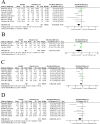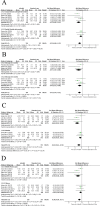eHealth interventions and patients with metabolic dysfunction-associated steatotic liver disease: a systematic review and meta-analysis
- PMID: 40204429
- PMCID: PMC11987102
- DOI: 10.1136/bmjgast-2024-001670
eHealth interventions and patients with metabolic dysfunction-associated steatotic liver disease: a systematic review and meta-analysis
Abstract
Objective: Metabolic dysfunction-associated steatotic liver disease (MASLD) is a growing global health concern, with increasing mortality rates driven by the obesity pandemic. Weight loss has been shown to improve MASLD outcomes, yet the effectiveness of eHealth interventions in MASLD management remains uncertain. We aimed to evaluate the effectiveness of eHealth interventions compared with standard care in improving health outcomes among patients with MASLD.
Design: A systematic review and meta-analysis were conducted in accordance with Preferred Reporting Items for Systematic Reviews and Meta-Analyses guidelines.
Data sources: Relevant studies were retrieved from PubMed, Cochrane Central and Embase databases from inception to 26 April 2024.
Eligibility criteria: Only double-arm clinical trials involving human participants diagnosed with MASLD were included. Eligible studies were limited to those published in English.
Data extraction and synthesis: eHealth interventions-including internet-based platforms, smartwatches, telephone follow-ups and mobile applications for dietary and exercise modifications-were compared against traditional intervention methods. The primary outcomes assessed were changes in body weight, abdominal/waist circumference, aspartate aminotransferase (AST) and alanine transaminase (ALT). Secondary outcomes were changes in body mass index (BMI), diastolic blood pressure, systolic blood pressure, MASLD fibrosis score, high-density lipoprotein, gamma-glutamyl transferase and triglycerides.
Results: 11 studies met the inclusion criteria, of which 10 provided relevant outcomes and were included. The mean age of participants across the studies ranged from 39.3 to 57.9 years, with intervention durations spanning 3 to 24 months. Our results indicate significant improvements with eHealth interventions compared with control comparators, including reductions in AST (standardised mean difference (SMD): -0.35 (95% CI -0.61, -0.10); p<0.05), ALT (SMD: -0.38 (95% CI -0.65, -0.11); p<0.05), weight loss (SMD: -0.38 (95% CI -0.60, -0.17); p<0.05) and BMI (SMD: -0.37 (95% CI -0.54, -0.21); p<0.05).
Conclusions: The utilisation of eHealth interventions showed significant improvements in outcomes related to AST, ALT, abdominal circumference, weight loss and BMI. However, future studies with larger sample sizes and longer follow-ups are warranted to assess the sustainability of these outcomes.
Keywords: META-ANALYSIS; Mobile Applications; NONALCOHOLIC STEATOHEPATITIS; Non-alcoholic Fatty Liver Disease; OBESITY.
© Author(s) (or their employer(s)) 2025. Re-use permitted under CC BY-NC. No commercial re-use. See rights and permissions. Published by BMJ Group.
Conflict of interest statement
Competing interests: None declared.
Figures



Similar articles
-
Interventions for weight loss in people with chronic kidney disease who are overweight or obese.Cochrane Database Syst Rev. 2021 Mar 30;3(3):CD013119. doi: 10.1002/14651858.CD013119.pub2. Cochrane Database Syst Rev. 2021. PMID: 33782940 Free PMC article.
-
Efficacy of the Mediterranean diet in treating metabolic dysfunction-associated steatotic liver disease (MASLD) in children and adolescents: a systematic review and meta-analysis.BMC Public Health. 2024 Oct 3;24(1):2701. doi: 10.1186/s12889-024-19378-w. BMC Public Health. 2024. PMID: 39363272 Free PMC article.
-
Gender Differences in Liver Steatosis and Fibrosis in Overweight and Obese Patients with Metabolic Dysfunction-Associated Steatotic Liver Disease before and after 8 Weeks of Very Low-Calorie Ketogenic Diet.Nutrients. 2024 May 8;16(10):1408. doi: 10.3390/nu16101408. Nutrients. 2024. PMID: 38794646 Free PMC article.
-
Efficacy of fish oil supplementation on metabolic dysfunction-associated steatotic liver disease: a meta-analysis.Front Nutr. 2025 Jan 24;12:1524830. doi: 10.3389/fnut.2025.1524830. eCollection 2025. Front Nutr. 2025. PMID: 39927279 Free PMC article.
-
The Role of Mobile Apps in Obesity Management: Systematic Review and Meta-Analysis.J Med Internet Res. 2025 May 6;27:e66887. doi: 10.2196/66887. J Med Internet Res. 2025. PMID: 40327853 Free PMC article. Review.
References
Publication types
MeSH terms
Substances
LinkOut - more resources
Full Text Sources
Medical
Miscellaneous
